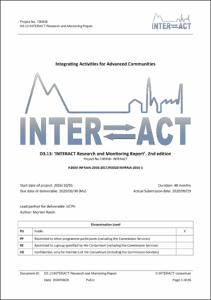| dc.contributor.author | Topp-Jørgensen, Elmer | |
| dc.contributor.author | Arndal, Marie Frost | |
| dc.contributor.author | Savela, Hannele | |
| dc.contributor.author | Rasch, Morten | |
| dc.coverage.spatial | Arctic Region | en_US |
| dc.date.accessioned | 2022-03-25T20:55:23Z | |
| dc.date.available | 2022-03-25T20:55:23Z | |
| dc.date.issued | 2020 | |
| dc.identifier.citation | Topp-Jørgensen, E., Arndal, M.F., Savela,m H. and Rasch, M. (2020) INTERACT Research and Monitoring Report 2020, D.3.13, 2nd edition. INTERACT Consortium, 85pp. DOI: http://dx.doi.org/10.25607/OBP-1734 | en_US |
| dc.identifier.uri | https://repository.oceanbestpractices.org/handle/11329/1897 | |
| dc.identifier.uri | http://dx.doi.org/10.25607/OBP-1734 | |
| dc.description.abstract | The Arctic is still an understudied part of the world, and restricted access or lack of infrastructure
makes arctic research more complicated than elsewhere. Coordinating activities, implementing
standards and data harmonization and sharing of data are therefore essential to make robust
assessments and predictions for the Arctic and northern cold regions.
In this report, INTERACT stations provide information on research activities at their stations, i.e.
what disciplines are studied at the station and what variables are monitored on a ‘long-term’
scale. Stations have also provided information about what scientific networks and organisations
they contributes to and we describe some of these global intergovernmental organisations, central
circumarctic coordinating organisations, important Arctic Council working groups and selected
scientific networks with standard protocols or data harmonization.
The report can hence be a tool for station managers to identify networks that they could
potentially contribute to, and for scientists and scientific networks to look for stations that could
fill potential data gaps on their geographical coverage to improve robustness of their coordinated
scientific efforts.
At the end of the report, we present two INTERACT tools that facilitate access to the Arctic.
1. The INTERACT GIS tool that allows scientists to explore station facilities and their
surroundings when looking for ideal study locations.
2. The INTERACT Access programme consisting of Transnational Access (physical access) to
research stations, Remote Access (samples/data collected by station staff) and Virtual
Access (online access to data sets). | en_US |
| dc.description.sponsorship | European Union; EU | en_US |
| dc.language.iso | en | en_US |
| dc.publisher | INTERACT Consortium | en_US |
| dc.subject.other | INTERACT | en_US |
| dc.title | INTERACT Research and Monitoring Report 2020. D3.13. 2nd edition | en_US |
| dc.type | Report | en_US |
| dc.description.status | Published | en_US |
| dc.format.pages | 85pp. | en_US |
| dc.description.refereed | Refereed | en_US |
| dc.subject.parameterDiscipline | Administration and dimensions | en_US |
| dc.description.currentstatus | Current | en_US |
| dc.description.sdg | 14.a | en_US |
| dc.description.eov | N/A | en_US |
| obps.resourceurl.publisher | https://eu-interact.org/download/deliverable-3-13-interact-research-and-monitoring-report/ | |
 Repository of community practices in Ocean Research, Applications and Data/Information Management
Repository of community practices in Ocean Research, Applications and Data/Information Management
